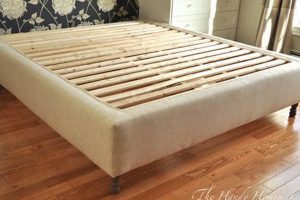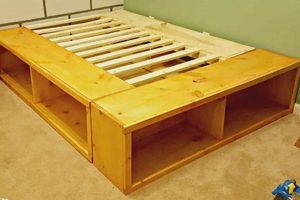A bed frame incorporating shelving units offers a dual-purpose furniture solution for bedrooms. This construction integrates storage directly into the structure supporting the mattress, providing a space-saving and organization-focused design. Consider, for example, a twin-sized sleeping platform with built-in cubbies along its sides, suitable for books, lamps, or personal items.
The integration of shelving into bed frames maximizes spatial efficiency, particularly beneficial in smaller living areas. Historically, adaptable furniture designs have been sought to optimize limited square footage. This type of structure addresses this need by combining essential resting arrangements with accessible storage, minimizing clutter and improving room functionality.
The following sections will detail the considerations involved in designing and constructing such a furniture piece, covering material selection, structural stability, design principles, and relevant safety precautions.
Construction and Design Recommendations
The following recommendations address essential considerations for designing and building a sleeping platform integrated with bookshelves. Adherence to these points will contribute to the structural integrity, functionality, and safety of the finished furniture.
Tip 1: Material Selection: Prioritize solid wood or high-quality plywood for structural components. Softwoods, such as pine, are suitable for shelving but may require reinforcement for load-bearing elements. MDF should be avoided for critical structural parts due to its lower load-bearing capacity and susceptibility to moisture damage.
Tip 2: Structural Support: Reinforce corners and joints with metal brackets or wood screws. Consider adding a central support beam if the structure is wider than a standard twin bed frame to prevent sagging. Evaluate the weight capacity of shelving units to ensure they can safely accommodate intended contents.
Tip 3: Design Planning: Create detailed blueprints before commencing construction. Accurately measure the mattress dimensions to ensure a snug fit. Plan the shelving layout to maximize storage while allowing adequate headroom for occupants.
Tip 4: Joint Construction: Employ strong joinery techniques, such as mortise and tenon, or dado joints, for enhanced stability. Secure all connections with wood glue and screws. Pilot holes are essential to prevent wood splitting during screw insertion.
Tip 5: Safety Considerations: Sand all edges and surfaces smooth to prevent splinters. Consider rounding sharp corners to mitigate potential injuries. Ensure proper ventilation within shelving units to prevent moisture buildup and mildew growth.
Tip 6: Finishing Touches: Apply a durable finish, such as varnish or polyurethane, to protect the wood from moisture and wear. Choose a non-toxic finish to minimize potential health risks. Consider the aesthetic integration of the project with the existing room decor when selecting a finish.
These recommendations represent crucial factors in achieving a structurally sound, functionally optimized, and safe sleeping and storage arrangement. Careful attention to these details will result in a long-lasting and valuable addition to the living space.
The subsequent sections will explore advanced design considerations and aesthetic integration strategies.
1. Structural Stability
The structural integrity of a sleeping platform incorporating shelving is paramount, directly impacting its safety and longevity. Compromised stability can lead to collapse, posing significant risks to occupants. Therefore, a rigorous approach to design and construction is essential.
- Load Distribution Analysis
Analyzing load distribution is critical. This involves calculating the total weight the structure will bear, including the mattress, occupants, and contents of the shelves. Improper load distribution can cause stress points and eventual failure. For instance, a design with shelving concentrated on one side may create an unbalanced load, requiring additional reinforcement on the opposite side to maintain equilibrium.
- Material Strength and Selection
The selection of materials directly influences the overall strength. Solid hardwoods like oak or maple offer superior load-bearing capabilities compared to softwoods or engineered wood composites. The thickness and quality of chosen material must be appropriate for the anticipated load. Using undersized lumber, for example, will inevitably compromise stability, regardless of the joinery techniques employed.
- Joinery Techniques
The method of joining structural components significantly affects the assembly’s resistance to stress. Robust joinery techniques, such as mortise and tenon, dovetail, or properly executed screw and glue joints, are essential for creating a rigid and durable framework. Weak or improperly executed joints will become points of failure under stress. Consider a scenario where butt joints are used without adequate reinforcement; these are prone to separation under repeated loading.
- Foundation and Support System
The foundation upon which the structure rests must be level and capable of supporting the combined weight. An uneven or unstable base will introduce stress and potentially lead to structural distortion over time. Furthermore, the support system, including legs or a solid base, must be designed to evenly distribute the load to the floor. Inadequate support can result in localized stress points and eventual collapse. Consider situations where thin legs are used to support a heavily loaded unit, increasing the chance of buckle or shear failures
These facets, when carefully considered and implemented, contribute to a sleeping platform capable of safely supporting the intended load. Ignoring any of these aspects can compromise the structural integrity, rendering the final product unsafe and unfit for its intended purpose. Regular inspection for signs of stress, such as creaking or sagging, is recommended throughout the lifespan of the structure, with timely repairs addressing any identified weaknesses.
2. Storage Optimization
Storage optimization, in the context of a sleeping platform integrated with shelving, represents a critical design consideration that directly impacts the usability and spatial efficiency of the furniture. The following elucidates key facets of optimizing storage within this framework.
- Vertical Space Utilization
Exploiting vertical space is fundamental. Utilizing the height above the sleeping area maximizes storage capacity within the existing footprint. Shelves extending upwards towards the ceiling provide room for books, decorative items, or personal belongings. The careful calibration of shelf height ensures usability without compromising headroom. For instance, higher shelves can accommodate less frequently accessed items, while those at arm’s reach can hold everyday essentials.
- Modular Shelf Design
Implementing a modular shelf system allows for customization and adaptability. Adjustable shelves accommodate items of varying sizes, maximizing storage efficiency. Furthermore, modular designs allow for future expansion or reconfiguration as storage needs evolve. Consider a system where shelves can be added, removed, or repositioned to accommodate changes in the user’s lifestyle or preferences.
- Concealed Storage Integration
Incorporating concealed storage compartments enhances organization and aesthetics. Drawers or cabinets integrated into the structure provide discreet storage for clothing, bedding, or personal items, maintaining a clean and uncluttered appearance. These concealed spaces can also serve as a secure location for valuables. Integrating drawers or cabinets directly beneath the sleeping platform is one possibility.
- Accessibility Considerations
Optimizing storage also involves ensuring ease of access. Shelves should be positioned at a comfortable reach, minimizing the need for stretching or bending. Proper lighting within the shelving units enhances visibility and usability, particularly in low-light conditions. The strategic placement of frequently used items on easily accessible shelves improves overall functionality.
These facets, when integrated effectively, transform a basic sleeping platform into a highly functional storage solution. By carefully considering vertical space utilization, modular design principles, concealed storage options, and accessibility considerations, one maximizes the storage potential of the structure, creating a practical and organized living space.
3. Material Durability
The longevity and performance of a sleeping platform incorporating shelving are intrinsically linked to the durability of the constituent materials. Material selection directly influences the structure’s ability to withstand daily use, resist environmental factors, and maintain its aesthetic appeal over time. Considerations extending beyond initial cost are crucial in ensuring long-term value and safety.
- Resistance to Load and Stress
The selected material must possess sufficient strength to bear the weight of the mattress, occupants, and stored items without deformation or failure. Hardwoods such as oak or maple exhibit superior load-bearing capabilities compared to softwoods or engineered composites. For example, using a softwood like pine for critical structural components in a full-sized unit may result in sagging or eventual collapse under sustained weight, requiring premature replacement or costly repairs. High-density plywood can offer a more economical alternative, provided it meets the required strength specifications.
- Resistance to Moisture and Wear
Bed frames are often subjected to varying levels of humidity and physical abrasion. Materials prone to moisture absorption, such as particleboard or untreated softwoods, can swell, warp, or develop mold and mildew, compromising structural integrity and posing potential health risks. Finishes such as varnish or polyurethane provide a protective barrier against moisture ingress and physical wear, extending the lifespan of the structure. Surfaces exposed to frequent contact should be finished with durable, scratch-resistant coatings.
- Resistance to Insect Infestation
Certain wood species are naturally more resistant to insect infestation than others. Cedar, for example, contains oils that deter many common wood-boring insects. Treating lumber with appropriate preservatives can also mitigate the risk of infestation. Untreated softwoods are particularly vulnerable, potentially leading to structural damage and necessitating expensive extermination or replacement efforts. Consider scenarios where untreated frames become homes for termites, undermining the structure’s stability over time.
- Dimensional Stability and Resistance to Warping
Variations in temperature and humidity can cause wood to expand or contract, potentially leading to warping, cracking, or joint separation. Kiln-dried lumber is more dimensionally stable than green lumber, reducing the risk of these issues. Engineered wood products, such as plywood, are less susceptible to warping than solid wood due to their cross-laminated construction. Choosing materials with inherent dimensional stability minimizes the risk of structural distortions that could compromise safety and aesthetic appeal. Consider the effect on the bed frame when exposed to seasonal environmental changes inside a typical home.
In conclusion, the selection of durable materials is a foundational element in the construction of a sleeping platform with shelving. Addressing factors such as load-bearing capacity, moisture resistance, insect infestation, and dimensional stability ensures a long-lasting, safe, and aesthetically pleasing final product. The increased initial investment in durable materials translates to reduced maintenance costs, prolonged lifespan, and enhanced overall value.
4. Design Ergonomics
Design ergonomics is a critical component in the construction of a sleeping platform integrated with shelving, impacting user comfort, accessibility, and safety. Suboptimal ergonomic design can result in physical strain, reduced functionality, and an increased risk of injury. A well-designed frame considers factors such as reach distance to shelves, height of the sleeping surface, and the overall arrangement of storage compartments, directly influencing the user experience.
For instance, shelving positioned too high or too low necessitates excessive reaching or bending, potentially leading to musculoskeletal strain. The height of the sleeping surface should be optimized for easy ingress and egress, particularly for individuals with mobility limitations. Furthermore, the depth and placement of shelving units should not impede movement around the bed, minimizing the risk of accidental collisions. Consider the example of a sleeping platform where the shelves protrude excessively into the walking area, creating a tripping hazard, especially in dimly lit environments. Proper ergonomic design mitigates these risks by adhering to anthropometric data and user-centered principles.
In conclusion, integrating ergonomic principles into the design phase of a shelving-integrated sleeping platform is essential for creating a user-friendly and safe environment. By carefully considering factors such as reach distance, sleeping surface height, and overall spatial arrangement, the design can minimize physical strain, enhance accessibility, and promote user well-being. Neglecting ergonomic considerations can compromise the functionality and safety of the structure, underscoring the importance of this design aspect.
5. Safety Standards
Adherence to safety standards is paramount in the design and construction of a sleeping platform incorporating shelving, given the potential for structural failure and personal injury. The integration of shelving into a bed frame introduces complexities in load distribution and structural integrity, necessitating rigorous attention to established safety protocols. Failure to meet these standards can result in collapse, instability, or hazards related to material toxicity and flammability.
Real-world examples underscore the importance of these standards. Instances of improperly constructed units collapsing under normal use highlight the need for accurate load calculations and robust joinery techniques. Furthermore, the use of non-compliant or untreated materials can lead to the release of volatile organic compounds (VOCs), posing respiratory risks to occupants. Similarly, materials that do not meet flammability standards can exacerbate fire hazards, increasing the risk of injury or death. Therefore, compliance with relevant building codes and safety regulations is essential to mitigate these risks.
In conclusion, safety standards are an indispensable component of a shelving-integrated sleeping platform. They serve as a framework for ensuring structural integrity, minimizing health hazards, and reducing the risk of fire-related incidents. Prioritizing adherence to these standards during the design and construction phases is crucial for creating a safe and functional piece of furniture.
6. Aesthetic Integration
Aesthetic integration, concerning a sleeping platform incorporating shelving, denotes the harmonious blending of the furniture piece with the existing decor and architectural style of the room. This consideration transcends mere functionality, focusing on the visual impact and overall design coherence of the structure within its intended environment.
- Material Palette Harmony
The selection of materials, finishes, and colors should complement existing furniture, wall colors, and flooring. Contrasting elements can be used to create visual interest, but the overall palette should maintain a sense of cohesion. For instance, a room with predominantly warm wood tones would benefit from a shelving-integrated bed frame constructed from similar materials or finished with a stain that echoes the existing color scheme. Conversely, stark contrasts may disrupt the visual harmony, creating a disjointed aesthetic.
- Style Consistency
The design style of the unit should align with the overall architectural style of the room. A modern minimalist bedroom benefits from clean lines, geometric shapes, and a lack of ornamentation. A rustic or farmhouse-style room, conversely, can accommodate more ornate designs and natural materials. Introducing a highly contemporary piece into a traditional setting, or vice versa, may create a visual dissonance that detracts from the overall aesthetic appeal.
- Scale and Proportion Considerations
The size and proportions of the shelving-integrated bed frame should be appropriate for the dimensions of the room. A large, bulky structure can overwhelm a small space, while a diminutive piece may appear insignificant in a larger setting. Careful consideration of scale is essential for achieving visual balance and preventing the furniture from dominating or disappearing within the room. The proportions of the shelving units relative to the sleeping platform itself also contribute to the overall aesthetic harmony.
- Functional Element Concealment
Aesthetically integrated designs often prioritize concealing functional elements, such as wiring, supports, or hardware. This can be achieved through clever design solutions that hide these components without compromising accessibility or functionality. For example, wiring for integrated lighting can be routed through hidden channels within the frame, and support structures can be seamlessly integrated into the shelving units. A clean and uncluttered appearance contributes to a more refined and visually appealing result.
These facets, when addressed holistically, contribute to a shelving-integrated sleeping platform that not only fulfills its functional purpose but also enhances the aesthetic quality of the room. Achieving successful aesthetic integration elevates the design from a mere piece of furniture to a cohesive element of the overall interior design scheme, contributing to a more visually pleasing and harmonious living space.
7. Cost Efficiency
The construction of a sleeping platform incorporating shelving as a self-directed project, is frequently motivated by the potential for cost savings compared to purchasing commercially manufactured alternatives. However, achieving genuine cost efficiency necessitates careful planning and execution, considering factors beyond initial material expenses. Inadequate planning or material mismanagement can negate potential savings and even result in higher overall costs. For instance, inaccurate measurements leading to material waste, or the selection of inappropriate joinery techniques requiring additional reinforcement, directly impact project expenditure. Furthermore, the omission of essential tools or safety equipment from the initial budget can lead to unexpected and potentially significant financial outlays. Therefore, a comprehensive cost-benefit analysis is crucial before commencing the project to ascertain its genuine economic viability.
The selection of materials plays a pivotal role in determining overall cost efficiency. Opting for reclaimed wood or utilizing readily available, less expensive lumber, such as pine, can significantly reduce material expenses. However, the long-term cost implications of these choices must be considered. While less expensive, softer woods may require more frequent maintenance or replacement compared to hardwoods, potentially offsetting initial savings over time. Similarly, sourcing materials from multiple vendors to secure the lowest prices can introduce logistical complexities and transportation costs that may diminish any price advantages. The judicious balancing of initial cost, material durability, and logistical considerations is therefore essential for maximizing cost efficiency.
In conclusion, while the endeavor offers the prospect of reduced expenditure, achieving genuine cost efficiency hinges on meticulous planning, prudent material selection, and a comprehensive understanding of associated expenses. Failure to account for potential pitfalls, such as material wastage, maintenance requirements, or logistical complexities, can undermine the economic viability of the project. Therefore, a thorough cost-benefit analysis and a commitment to efficient resource management are critical for realizing the intended financial advantages.
Frequently Asked Questions
The subsequent section addresses common inquiries regarding the construction and implementation of sleeping platforms with integrated shelving. The information provided aims to clarify key considerations and address potential concerns.
Question 1: Is specialized carpentry experience necessary for construction?
While advanced carpentry skills are not strictly required, a foundational understanding of woodworking techniques is beneficial. Familiarity with basic tools, accurate measurement, and joinery methods enhances the probability of a structurally sound and aesthetically pleasing final product. Novice builders may consider starting with simpler designs and gradually progressing to more complex configurations.
Question 2: What are the primary safety concerns associated with this type of furniture?
The primary safety concerns revolve around structural integrity and load-bearing capacity. Ensuring the design can adequately support the weight of the mattress, occupants, and stored items is critical. Additionally, the selection of non-toxic materials and the mitigation of sharp edges or protruding hardware are essential safety considerations.
Question 3: How does the construction impact the weight and portability of the bed frame?
The integration of shelving significantly increases the overall weight of the bed frame, potentially reducing its portability. Disassembly and reassembly may require multiple individuals and specialized tools. Modular designs or the use of lightweight materials can mitigate this issue to some extent; however, the added weight remains a factor.
Question 4: Are there specific building codes or regulations that govern this type of construction?
Local building codes may impose regulations concerning structural safety, fire resistance, and material toxicity. It is incumbent upon the builder to research and comply with all applicable codes and regulations to ensure the safety and legality of the structure.
Question 5: What are the long-term maintenance requirements for a sleeping platform with integrated shelving?
Long-term maintenance primarily involves periodic inspection for structural integrity, tightening of loose joints, and refinishing of surfaces to prevent wear and moisture damage. Regular cleaning is also essential to prevent dust accumulation and maintain a hygienic sleeping environment.
Question 6: Does integrating shelving compromise the comfort of the sleeping platform?
When designed and constructed thoughtfully, integrating shelving does not inherently compromise the comfort of the sleeping platform. However, inadequate consideration of headroom, protruding shelf edges, or noise transmission through the structure can negatively impact the user experience. Careful design and material selection mitigate these potential issues.
In summary, constructing a sleeping platform with integrated shelving requires careful consideration of safety, structural integrity, and regulatory compliance. Thorough planning and adherence to best practices enhance the likelihood of a successful outcome.
The subsequent section will delve into strategies for adapting existing bed frames to incorporate shelving units.
diy bookshelf bed frame
This exploration has elucidated the multifaceted nature of constructing a sleeping platform with integrated shelving. Key points emphasized encompass structural stability, optimized storage, material durability, ergonomic considerations, adherence to safety standards, aesthetic integration, and cost efficiency. The success of such an undertaking hinges upon the meticulous application of these principles.
The construction of a “diy bookshelf bed frame” represents a significant undertaking with lasting implications for space optimization and functionality. Continued adherence to safety standards and ongoing assessment of structural integrity are paramount. The integration of these design principles has the potential to transform the living environment, promoting both utility and aesthetic appeal.







